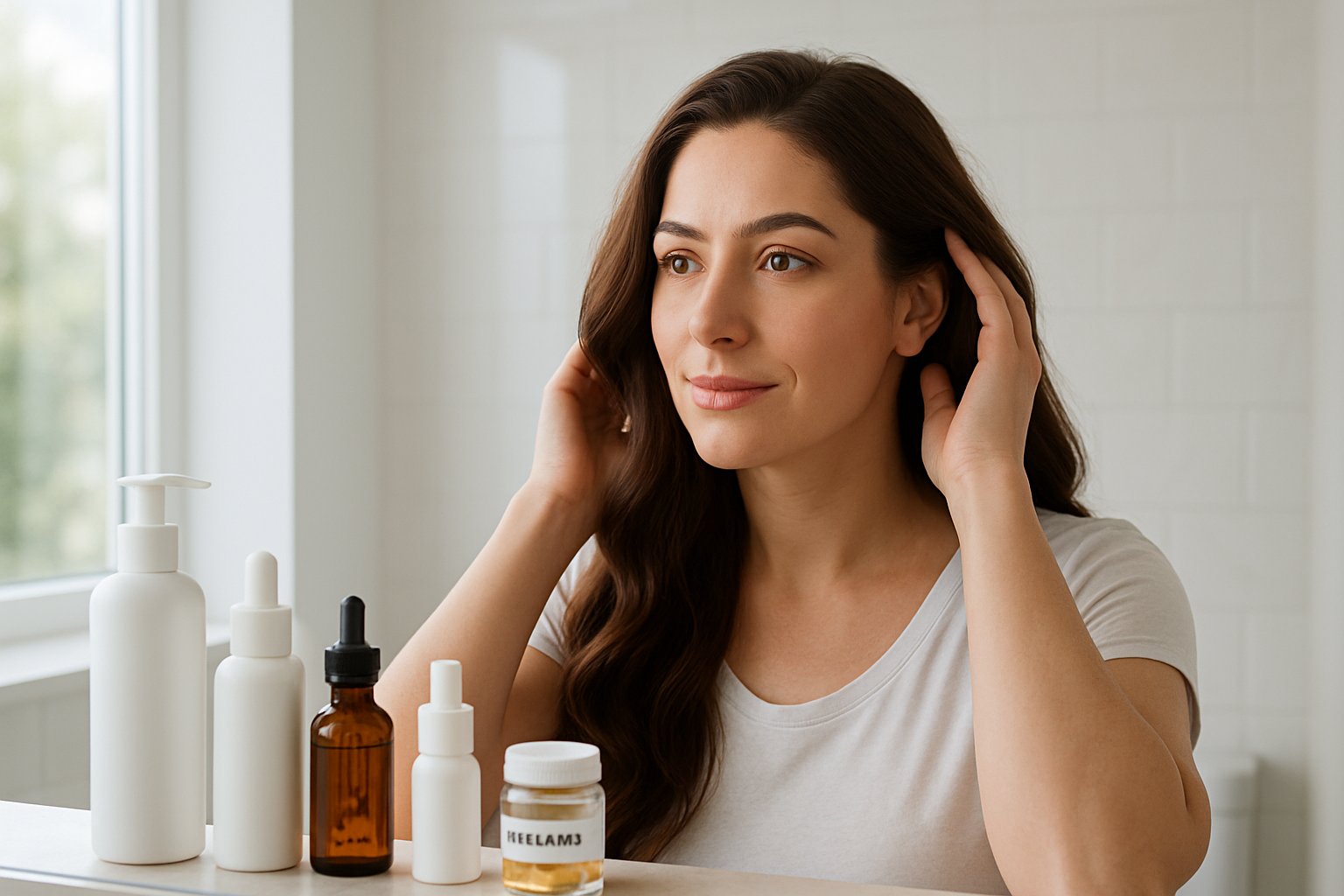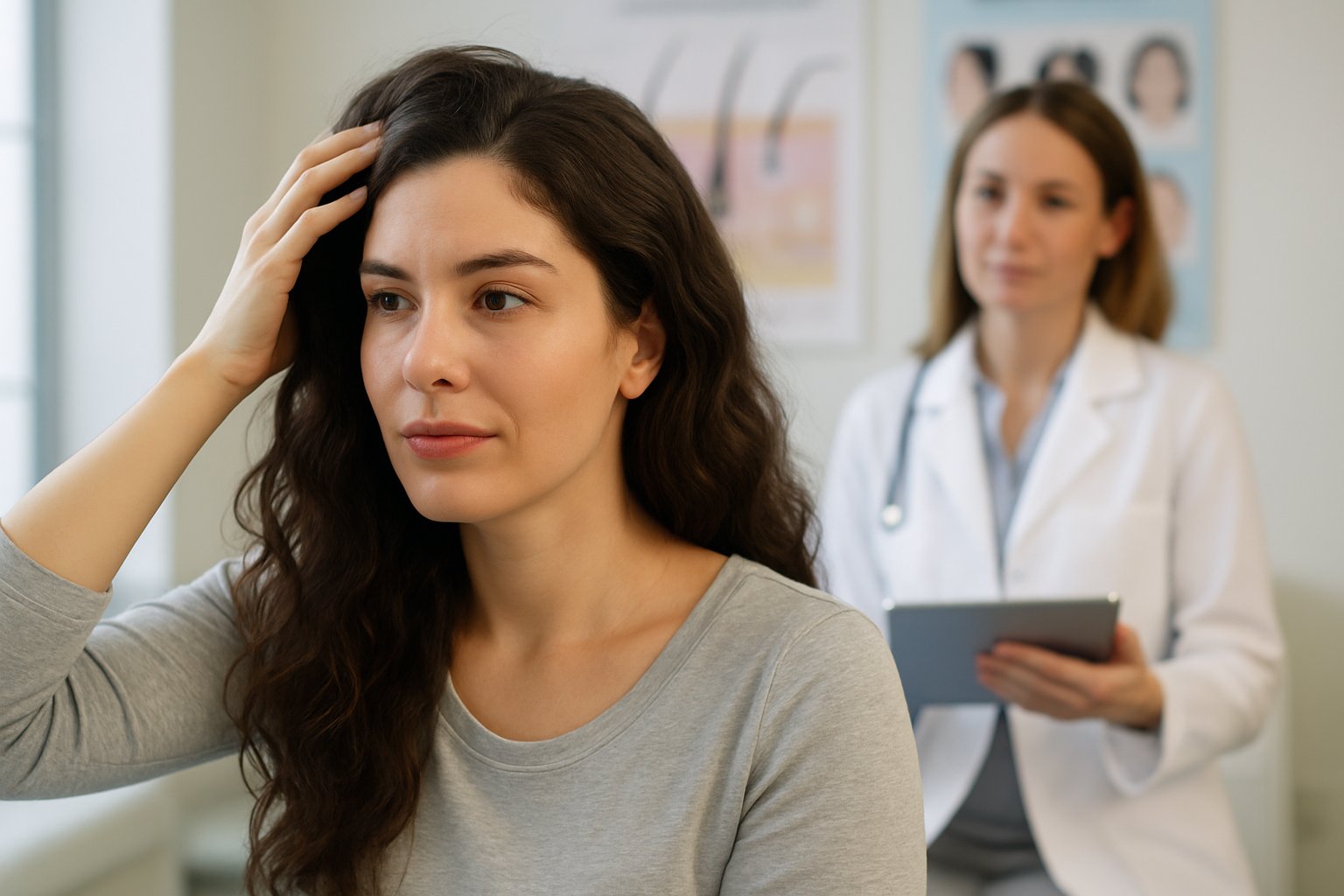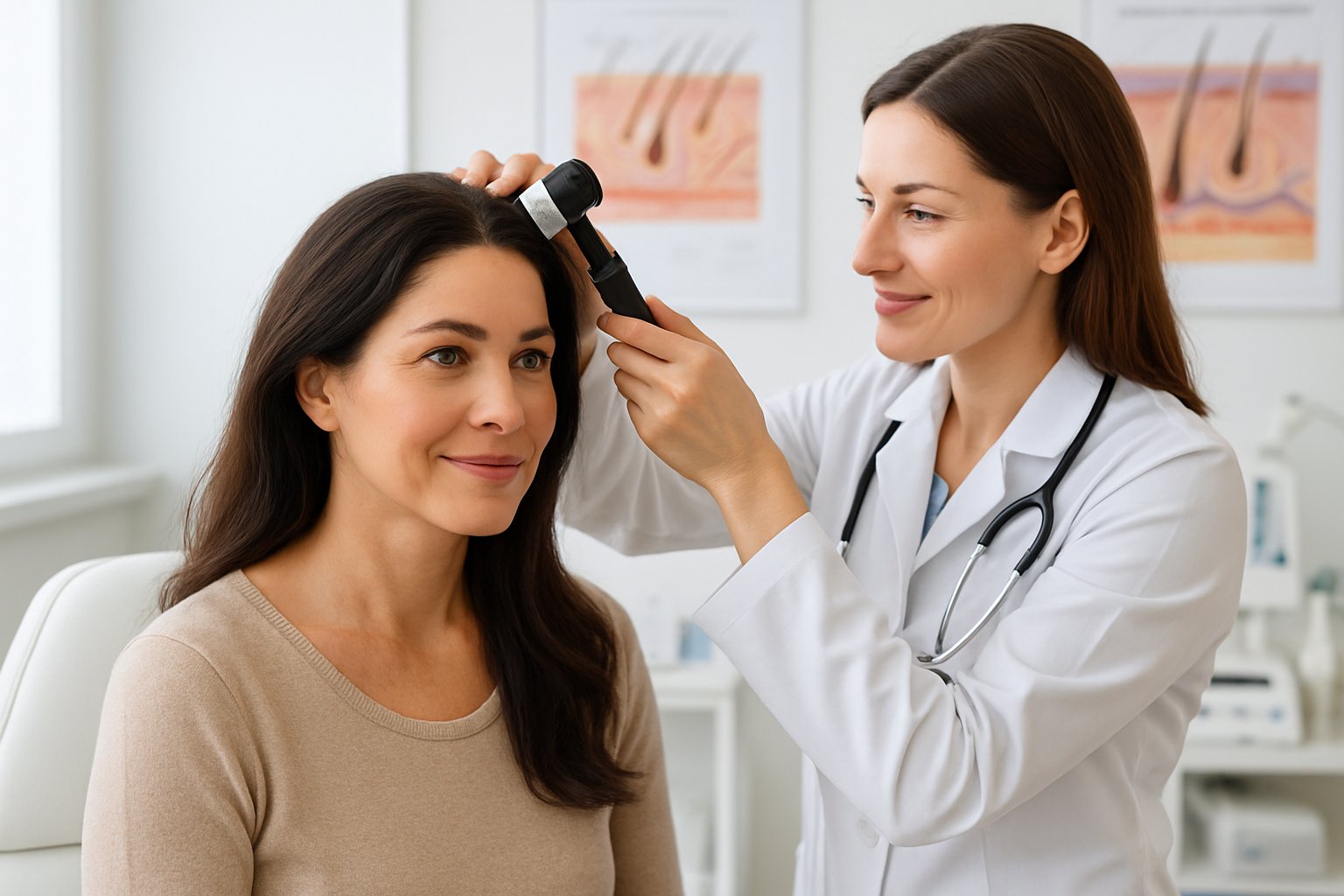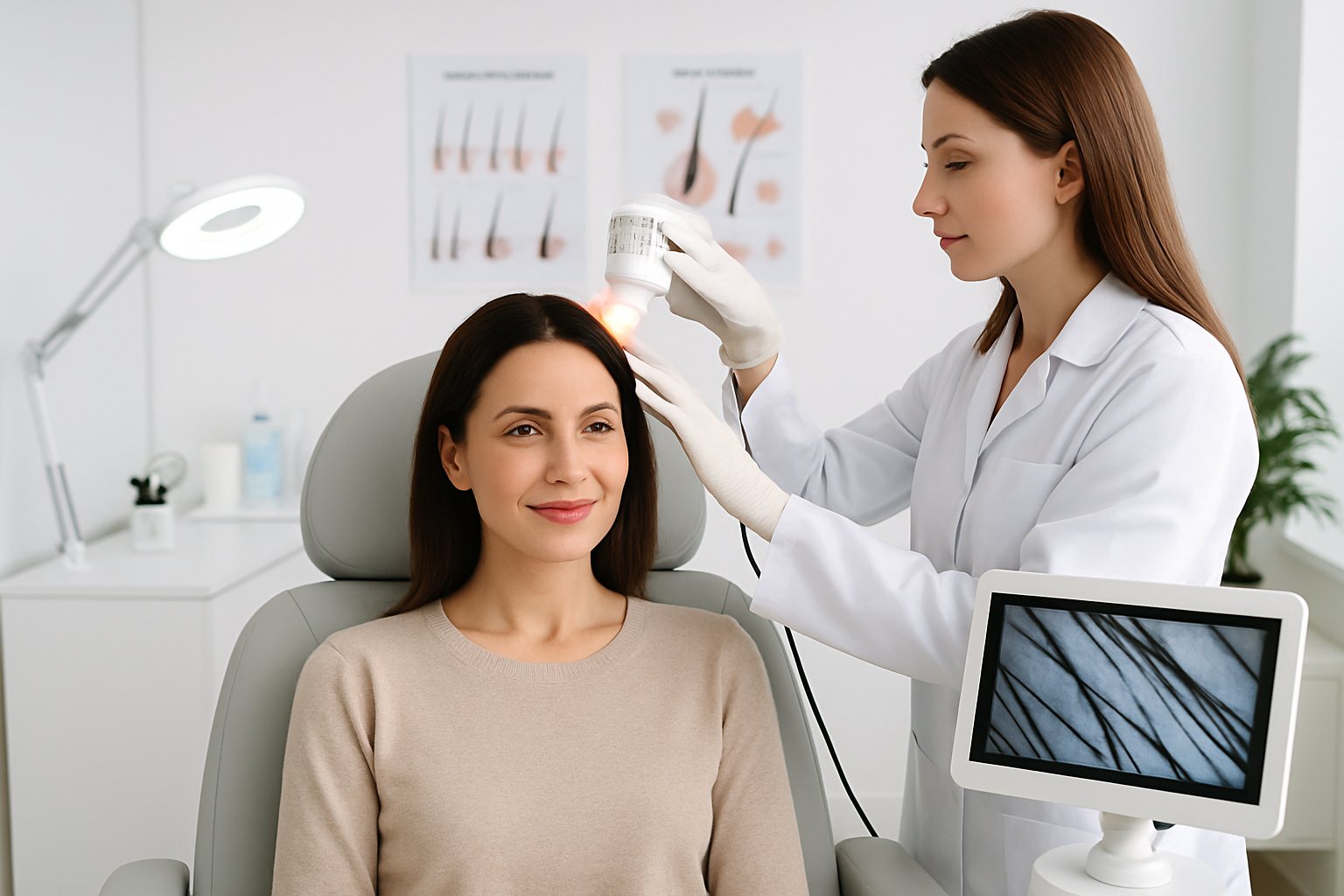Hair loss affects millions of women worldwide, with nearly 40% of women experiencing hair loss by age 65[1]. Unlike male pattern baldness, female hair loss often presents as gradual thinning across the scalp rather than distinct bald patches. This condition can significantly impact self-confidence and quality of life, making it essential for women to understand their treatment options.

Women experiencing hair loss have access to multiple proven treatment approaches, ranging from over-the-counter medications to advanced medical procedures. The most common cause is female pattern hair loss, which leads to thinning and shedding on the front and top of the scalp[2]. Treatment effectiveness varies depending on the underlying cause, timing of intervention, and individual response to therapy.
Modern hair loss treatments offer hope for women seeking to prevent further thinning and potentially restore hair growth. From FDA-approved medications to cutting-edge procedures, understanding the available options empowers women to make informed decisions about their hair health. Early intervention typically yields the best results, making it crucial to recognize the signs and seek appropriate treatment promptly.
Key Takeaways
- Female pattern hair loss is the most common type, causing gradual thinning on the front and top of the scalp
- Treatment options include prescription medications, over-the-counter solutions, and advanced medical procedures
- Early intervention provides the best outcomes for preventing hair loss and promoting regrowth
Understanding Female Hair Loss

Women experience several distinct types of hair loss, with female pattern hair loss being the most common form affecting over half of all women. Hormonal fluctuations during pregnancy, menopause, and periods of high stress can trigger temporary or permanent hair thinning through various mechanisms.
Types of Hair Loss in Women
Female pattern hair loss affects more than 50 percent of women[3] and represents the most frequent cause of thinning hair. This condition typically creates a widening part line and diffuse thinning across the crown and top of the scalp.
Telogen effluvium causes widespread hair shedding when hair follicles enter the resting phase prematurely. Women may lose 300-500 hairs daily instead of the normal 50-100 strands.
Alopecia areata creates distinct bald patches when the immune system attacks hair follicles. These circular areas of complete hair loss can appear suddenly and may affect any part of the scalp.
Traction alopecia develops from tight hairstyles that pull on hair roots over time. Ponytails, braids, and hair extensions commonly cause this preventable form of hair loss along the hairline.
Genetic Factors and Androgenetic Alopecia
Androgenetic alopecia, also called androgenic alopecia, stems from inherited sensitivity to androgens like testosterone. Hair follicles gradually shrink when exposed to dihydrotestosterone (DHT), a hormone derived from testosterone.
Women inherit hair loss genes from both parents, not just the mother’s side as commonly believed. Multiple genes influence hair loss susceptibility, making it difficult to predict who will develop thinning hair.
The condition typically begins with subtle widening of the center part. Hair becomes progressively thinner and shorter as affected follicles produce increasingly fine strands before eventually stopping growth entirely.
Hormonal Changes: Pregnancy, Childbirth, and Menopause
Pregnancy often creates thicker, fuller hair as elevated estrogen levels keep more follicles in the growth phase. Many women notice improved hair quality during their second and third trimesters.
Postpartum hair loss occurs 2-6 months after childbirth when hormone levels normalize rapidly. The excess hair retained during pregnancy sheds all at once, creating alarming but temporary hair loss.
Menopause brings declining estrogen and progesterone levels while androgen influence remains steady. This hormonal shift can trigger or accelerate female pattern hair loss in genetically susceptible women.
Thyroid disorders frequently affect hair growth patterns. Hyperthyroidism causes hair to become fine and brittle, while hypothyroidism leads to coarse, dry hair that breaks easily and grows slowly.
Stress-Related and Medical Causes
Physical and emotional stress can push hair follicles into premature resting phases, causing telogen effluvium. Surgery, severe illness, extreme weight loss, and psychological trauma commonly trigger this temporary condition.
Nutritional deficiencies in iron, protein, zinc, and B vitamins disrupt normal hair growth cycles. Restrictive diets and eating disorders frequently cause diffuse hair thinning that resolves with proper nutrition.
Certain medications including blood thinners, antidepressants, and chemotherapy drugs can cause hair loss as a side effect. Autoimmune conditions like lupus and inflammatory disorders also affect hair follicle health and growth patterns.
When to See a Dermatologist

Hair loss treatment[4] requires proper medical evaluation to identify the specific cause and develop an effective plan. Early professional intervention by a dermatologist can prevent further progression and improve treatment outcomes.
Diagnosing the Underlying Cause
A dermatologist has specialized knowledge to identify the many different causes of hair loss in women. They can distinguish between temporary shedding and permanent hair loss conditions.
Common diagnostic methods include:
- Physical examination of the scalp and hair
- Medical history review
- Blood tests to check hormone levels
- Scalp biopsy in some cases
- Pull test to assess hair strength
Women should see a dermatologist when they lose more than 125 hairs per day. This amount indicates hair loss in women[5] that needs medical attention.
Other warning signs include sudden bald patches, scalp irritation, or unusual thinning patterns. These symptoms often point to specific conditions that require different treatments.
The dermatologist will also ask about medications, stress levels, and recent life changes. These factors can all contribute to hair loss in women.
Importance of Early Medical Intervention
Early treatment prevents hair loss from getting worse. Many hair loss conditions respond better when caught in the early stages.
Some types of hair loss can become permanent if left untreated. Scarring alopecia, for example, destroys hair follicles completely. Quick medical care can stop this process.
Benefits of early intervention:
- More treatment options available
- Better chance of hair regrowth
- Prevention of permanent damage
- Reduced emotional distress
Waiting too long can limit treatment success. Hair follicles that have been inactive for years may not respond to therapy.
A dermatologist can also rule out serious health conditions. Some types of hair loss signal thyroid problems, autoimmune diseases, or nutritional deficiencies that need medical treatment.
Early diagnosis also helps women avoid ineffective over-the-counter products. Professional diagnosis and treatment[4] saves time and money while providing real results.
Medical Treatments for Preventing Hair Loss

Several FDA-approved medications and medical procedures can effectively slow or stop hair loss in women. These treatments work through different mechanisms, from increasing blood flow to hair follicles to blocking hormones that cause thinning.
Topical Treatments: Minoxidil and Rogaine
Minoxidil is the most widely used topical treatment for female hair loss. The FDA approved this medication for women in concentrations of 2% and 5%.
Rogaine is the brand name version of minoxidil. Both generic minoxidil and Rogaine work by widening blood vessels around hair follicles. This increases blood flow and delivers more nutrients to the hair roots.
Women typically apply the solution or foam twice daily to the scalp. Results become visible after 3-4 months of consistent use. Hair loss treatments for women[2] include both prescription and over-the-counter options like minoxidil.
Side effects may include:
- Scalp irritation
- Unwanted facial hair growth
- Initial increased hair shedding
The treatment works best for crown thinning rather than receding hairlines. Women must continue using minoxidil indefinitely to maintain results.
Oral Medications: Spironolactone and Finasteride
Spironolactone blocks male hormones called androgens that contribute to hair loss. Doctors prescribe doses between 100-200mg daily for hair loss treatment.
This medication works particularly well for women with female-pattern hair loss linked to hormone imbalances. Women may see improvement after 6-12 months of treatment.
Common side effects include irregular periods, breast tenderness, and increased urination. Women of childbearing age need regular monitoring due to potential birth defect risks.
Finasteride (brand name Propecia) blocks the enzyme that converts testosterone to DHT. DHT is the hormone that shrinks hair follicles in pattern hair loss.
The FDA has not approved finasteride for women’s hair loss. However, some doctors prescribe it off-label for postmenopausal women. Pregnant women must never use finasteride due to severe birth defect risks.
Platelet-Rich Plasma Therapy
Platelet-rich plasma therapy uses the patient’s own blood to stimulate hair growth. Doctors draw blood, separate the platelets, and inject the concentrated plasma into the scalp.
The platelets contain growth factors that may awaken dormant hair follicles. Medical treatments[6] include platelet-rich plasma as a nondrug option for female-pattern hair loss.
Treatment process:
- Blood draw (30-60ml)
- Centrifuge separation
- Scalp injections
- 3-4 sessions spaced 4-6 weeks apart
Studies show modest improvements in hair density and thickness. The procedure causes minimal side effects since it uses the patient’s own blood. Results vary significantly between individuals, and maintenance treatments are typically needed.
Advanced and In-Office Procedures

Professional medical treatments offer more intensive solutions for women experiencing significant hair loss. These procedures use specialized technology and require trained medical professionals to perform them safely and effectively.
Low-Level Laser Therapy (LLLT)
Low-level laser therapy uses red light energy to stimulate hair follicles and encourage new growth. The treatment works by targeting the mitochondria in hair cells with specific light wavelengths.
During treatment, patients sit under a device that emits painless “cool” red light onto the scalp. The light energy helps reset dormant hair follicles and extends the growth phase of existing hairs.
Studies show LLLT helps reduce hair shedding[7] and promotes healthier-looking hair. The treatment stimulates blood flow to hair follicles and increases cellular activity.
Treatment costs range from $1,500 to $3,500 per session. Most patients need multiple sessions spaced several weeks apart for optimal results.
Microneedling and Other Dermatological Procedures
Microneedling involves rolling fine needles across the scalp to create tiny punctures in the skin. This process triggers the body’s natural healing response and stimulates hair growth.
The procedure creates micro-channels that improve absorption of topical treatments like minoxidil. Many dermatologists combine microneedling with other hair loss medications for better results.
Treatment sessions typically cost between $200 and $700 each. Insurance usually does not cover these cosmetic procedures.
Other dermatological treatments include scalp injections and prescription medications. These options require evaluation by a qualified dermatologist who specializes in hair loss conditions.
Hair Transplant Surgery
Hair transplant procedures move healthy hair follicles from dense areas to thinning or balding spots. Modern techniques use local anesthesia and cause minimal scarring or downtime.
Women need adequate donor hair at the back of their head for successful transplants. Surgeons extract individual follicles and carefully implant them in target areas.
Costs range from $5,000 to $15,000 depending on the number of grafts needed. The procedure requires several hours and healing takes 7-14 days.
Results appear gradually over 6-12 months as transplanted hairs establish new growth cycles. Most patients achieve permanent, natural-looking results with proper candidate selection.
Lifestyle and Nutritional Strategies

Simple changes to diet, hair care routines, and stress management can significantly impact hair health. Iron deficiency remains a key factor in women’s hair loss, while gentle styling practices and stress reduction techniques support overall hair retention.
Nutrition and Iron Deficiency
Iron deficiency affects up to 25% of women and directly contributes to hair thinning. Women lose iron through menstruation, making adequate intake essential for healthy hair growth.
Key Iron-Rich Foods:
- Red meat and poultry
- Fish and shellfish
- Beans and lentils
- Spinach and dark leafy greens
- Fortified cereals
Women need 18 mg of iron daily before menopause and 8 mg after. Combining iron-rich foods with vitamin C sources like citrus fruits or bell peppers improves absorption.
Blood tests can confirm iron deficiency. Low ferritin levels below 40 ng/mL may contribute to hair loss even without anemia.
Other nutrients support hair health including protein, zinc, and B vitamins. A balanced diet with adequate calories prevents nutritional deficiencies that worsen hair loss.
Hair-Friendly Habits and Styling
Heat styling tools like curling irons damage hair shafts when used above 300°F. Lower temperatures and heat protectant sprays reduce breakage and splitting.
Gentle Hair Practices:
- Air dry when possible
- Use wide-tooth combs on wet hair
- Sleep on silk or satin pillowcases
- Avoid tight ponytails and braids
Chemical treatments including bleaching, perming, and frequent coloring weaken hair structure. Spacing treatments at least 6-8 weeks apart allows recovery time.
Coconut oil penetrates hair shafts better than other oils due to its molecular structure. Applied as a pre-shampoo treatment, it reduces protein loss during washing.
Regular scalp massage increases blood flow to hair follicles. Gentle circular motions with fingertips for 5-10 minutes daily may stimulate growth.
Managing Stress and Its Impact
Chronic stress triggers telogen effluvium, causing hair follicles to enter resting phase prematurely. This leads to diffuse thinning 2-3 months after stressful events.
High cortisol levels from ongoing stress disrupt the hair growth cycle. Stress management techniques help maintain normal hormone balance and hair retention.
Effective Stress Reduction Methods:
- Regular exercise (30 minutes daily)
- Meditation or deep breathing
- Adequate sleep (7-9 hours nightly)
- Social support and counseling
Physical stressors like crash dieting, surgery, or illness also cause temporary hair loss. Maintaining stable nutrition and health routines supports hair recovery.
Stress-related hair loss is usually reversible once cortisol levels normalize. Recovery typically takes 6-12 months as new hair growth replaces shed strands.
Natural and Supportive Remedies

Several natural approaches can complement medical treatments for hair loss prevention. Scalp massage techniques improve blood flow to hair follicles, while specific oils provide nourishment and moisture to support healthy hair growth.
Scalp Massage and Circulation Enhancement
Regular scalp massage increases blood circulation to hair follicles. This improved blood flow delivers essential nutrients and oxygen that support hair growth.
Women can perform scalp massage using their fingertips in circular motions. Apply gentle pressure for 5-10 minutes daily. The massage should cover the entire scalp from the hairline to the nape of the neck.
Daily Massage Routine:
- Morning: 3-5 minutes before styling
- Evening: 5-7 minutes before bed
- Weekly: 15-minute deep massage with oils
Studies show that consistent scalp massage can increase hair thickness over time. The mechanical stimulation helps strengthen hair follicles and may reduce inflammation.
Some women use massage tools like silicone brushes or wooden combs. These tools can enhance the massage effect but gentle finger pressure works equally well.
At-Home Oils and Products
Natural oils provide deep moisturizing benefits for both scalp and hair strands. Coconut oil penetrates the hair shaft better than many other oils due to its molecular structure.
Effective Hair Oils:
| Oil Type | Primary Benefit | Application Method |
|---|---|---|
| Coconut oil | Deep penetration and moisture | Apply to damp hair, leave 30 minutes |
| Rosemary oil | Circulation stimulation | Mix with carrier oil, massage into scalp |
| Jojoba oil | Scalp balance | Apply to scalp 2-3 times weekly |
Women should apply oils to clean, slightly damp hair for better absorption. Leave treatments on for 30 minutes to 2 hours before washing out with gentle shampoo.
Gentle, natural, and organic products[8] work best for supporting hair health without causing irritation. Avoid products with harsh chemicals that can damage hair follicles.
Some women see improvements in hair texture and reduced breakage within 4-6 weeks of consistent oil treatments.
Frequently Asked Questions

Women facing hair loss often have specific questions about treatment effectiveness, underlying causes, and practical solutions. Understanding the connection between hormones, nutrition, and hair health helps women make informed decisions about their care.
What are the most effective treatments for female hair loss?
The most effective treatments depend on the type and cause of hair loss. Minoxidil is one of the most proven topical treatments for women.
This medication helps stimulate hair follicles and slow hair loss. It comes in foam or liquid form and requires daily application to the scalp.
Prescription medications like spironolactone can help women with hormone-related hair loss. These treatments work by blocking hormones that contribute to hair thinning.
Hair loss treatments for women[9] include both prescription and over-the-counter options. Many women see results by combining different treatment approaches.
Supplements containing biotin, iron, and other nutrients can support hair growth. However, these work best when addressing specific nutrient deficiencies.
How can hormonal imbalances affect hair loss in women?
Hormonal changes are a major cause of hair loss in women. Androgens like testosterone can shrink hair follicles and shorten the hair growth cycle.
During menopause, estrogen levels drop while androgen levels remain stable. This shift often leads to thinning hair on the top and crown of the head.
Thyroid disorders affect hair growth cycles throughout the body. Both overactive and underactive thyroid conditions can cause hair to become thin and brittle.
PCOS causes elevated androgen levels in women. This condition often leads to male-pattern baldness and requires specific hormone-balancing treatments.
Pregnancy and postpartum periods create dramatic hormone shifts. Many women experience temporary hair loss three to six months after giving birth.
What vitamin deficiencies are linked to hair loss in women?
Iron deficiency is the most common nutritional cause of hair loss in women. Low iron levels reduce oxygen delivery to hair follicles.
Women with heavy menstrual periods are at higher risk for iron deficiency. Blood tests can confirm if iron levels are contributing to hair loss.
Vitamin D deficiency affects hair follicle health and growth cycles. Many women have low vitamin D levels, especially during winter months.
B vitamins, particularly biotin and B12, play important roles in hair growth. Deficiencies in these vitamins can lead to weak, thinning hair.
Zinc deficiency can cause hair loss and slow regrowth. This mineral is essential for protein synthesis in hair follicles.
What are the best ways to regrow thinning hair in women?
Starting treatment early gives the best chance for hair regrowth. Hair loss treatments work better[1] when follicles are still active but weakened.
Consistent use of minoxidil shows results in three to six months. Women need to apply this treatment daily and continue long-term use.
Low-level laser therapy stimulates blood flow to hair follicles. These devices use red light to encourage cellular activity in the scalp.
Platelet-rich plasma treatments inject concentrated growth factors into the scalp. This procedure can help wake up dormant hair follicles.
Hair transplant procedures move healthy follicles to thinning areas. This surgical option works well for women with specific patterns of hair loss.
What natural remedies are recommended for women experiencing hair loss?
Scalp massage increases blood circulation to hair follicles. Using fingertips or a scalp massager for five minutes daily can support hair health.
Essential oils like rosemary and peppermint may stimulate hair growth. These oils should be diluted with carrier oils before applying to the scalp.
Saw palmetto extract blocks enzymes that convert testosterone to DHT. This natural supplement may help reduce hormone-related hair loss.
Green tea contains antioxidants that protect hair follicles from damage. Drinking green tea or applying cooled tea to the scalp provides these benefits.
Reducing stress through yoga, meditation, or exercise helps prevent stress-related hair loss. Chronic stress can push hair follicles into resting phases.
What advice do dermatologists give for managing hair loss in women?
Dermatologists recommend seeing a specialist when women lose more than 125 hairs per day[5]. Early evaluation helps identify treatable causes.
Gentle hair care practices prevent additional damage to thinning hair. This includes using wide-tooth combs and avoiding tight hairstyles.
Protection from sun exposure helps maintain scalp and hair health. Wearing hats or using products with UV protection prevents damage.
Professional evaluation helps determine[10] the specific type of hair loss and best treatment approach. Different conditions require different treatments.
Regular follow-up appointments help track treatment progress. Dermatologists can adjust treatment plans based on how well therapies are working.
Managing underlying health conditions like thyroid disorders supports hair growth. Treating root causes often improves hair loss symptoms.
References
- Best Hair Loss Treatments for Women in 2025. https://www.ncoa.org/product-resources/hair-loss/best-hair-loss-treatments-for-women/ Accessed October 21, 2025
- Access to this page has been denied. https://www.goodrx.com/conditions/hair-loss/best-hair-loss-treatment-for-female Accessed October 21, 2025
- Female pattern hair loss affects more than 50 percent of women. https://www.oprahdaily.com/beauty/hair/a66452906/women-hair-loss-causes-fixes/ Accessed October 21, 2025
- Hair loss: Diagnosis and treatment. https://www.aad.org/public/diseases/hair-loss/treatment/diagnosis-treat Accessed October 21, 2025
- Hair Loss in Women: Causes, Treatment & Prevention. https://my.clevelandclinic.org/health/diseases/16921-hair-loss-in-women Accessed October 21, 2025
- Just a moment.... https://www.nejm.org/doi/full/10.1056/NEJMcp2412146 Accessed October 21, 2025
- Best Treatments for Hair Loss Recommended By Doctors. https://www.firstforwomen.com/beauty/hair/best-treatments-for-hair-loss-recommended-by-doctors Accessed October 21, 2025
- 10 Effective Natural Treatments for Hair Loss. https://naturemed.org/10-effective-natural-treatments-for-hair-loss/ Accessed October 21, 2025
- Access to this page has been denied. https://www.goodrx.com/conditions/hair-loss/hair-loss-treatment Accessed October 21, 2025
- Hair Loss (Alopecia) Prevention and Treatment in Women. https://www.uchicagomedicine.org/conditions-services/womens-health/hair-loss-alopecia-prevention-treatment Accessed October 21, 2025
